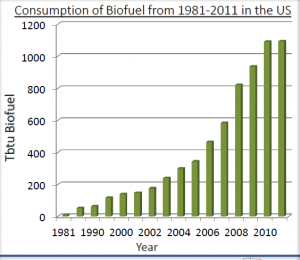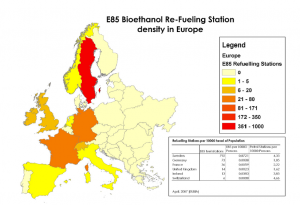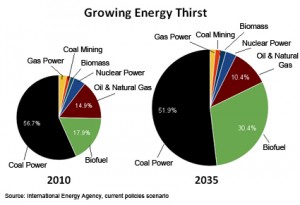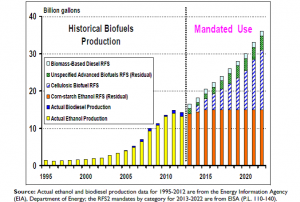- In 1981 ethanol fuel only produced 7 TBtu, today ethanol fuel produces 1,128 TBtu. (EPA)
- In 2001 biodiesel produced only 1 TBtu, in 2013 biodiesel produced 171 TBtu. (EPA)
- The trend of increasing production of biofuels is due to growing consumption of biofuels.
 However, the production of biofuels puts strain on water resources, soil quality and can take away from global food resources.
However, the production of biofuels puts strain on water resources, soil quality and can take away from global food resources.- Biofuels could only meet future energy demands if it can avoid increasing farmland while allowing agriculture to still meet the demands for both food and fuel production.
- If fuel efficiency was improved, and therefore took away from the demand of fuel, combined with an increase in biomass and food production on existing farmland , biofuels then has the potential to meet a substantial portion of future energy demands. (Tilman)
- Globally there is a growing demand for biofuels, the figure above shows the growing availability in the Eastern part of Europe of fueling stations.
- The Intentional Energy Agency (IEA) does see increasing demand for energy usage from the use of biofuels. However they do warn that countries need to make mandates on the greenhouse gas emissions that are produced from biofuels, before expanding the production of biofuels. The figure below shows global energy usage increasing from 17.9% in 2010 to 30.4% in 2035.
- By 2050, biofuels have the potential to account for 27% of the world’s transportation fuels, this would be 32 exajoules.
- Due to mandated increase in biofuels under the Renewable Fuels Standards regulated by the EPA, the US will have to increase energy usage of biofuels in the future. For more information on this see “Environmental Policy”
Primary Author: Kaitlyn Koch
Editors: Harrison Congdon, John Marshall
Resources:
Tilman, David, Robert Socolow, and Jonathan Foley. “Benefical Biofuels.” Science Magazine 17 July 2009: 270-71. Web. 30 Apr. 2014.
US Energy Information Administration. “Monthly Energy Review.” EIA. N.p., Mar. 2014. Web. 9 Apr. 2014.
http://www.iea.org/publications/freepublications/publication/Biofuels_Roadmap_WEB.pdf
http://www.erec.org/fileadmin/erec_docs/Projcet_Documents/RESTMAC/Brochure5_Bioethanol_low_res.pdf


